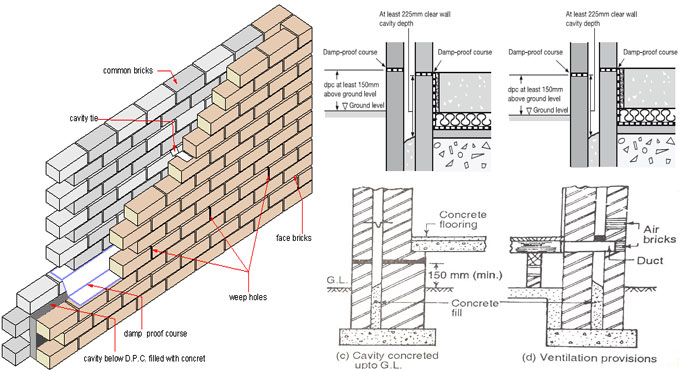
The construction process and benefits of cavity walls

Cavity wall stands for a double wall that comprises of two individual walls of masonry known as skins or leaves which are detached with an air space and connected jointly through metal ties at proper distances.
These walls are normally used as outside walls but sometimes used also as interior walls because of good sound.
Construction Methods of Cavity Wall
The two leaves of a cavity wall contain same thickness when it belongs to a non load bearing wall or the inside leaf becomes thicker as compared to exterior leaf to comply with the structural needs.
The interior and exterior skins of the wall are sufficiently knotted jointly with special wall ties involving minimum five ties per square meter of wall.
The cavity wall should not remain under 40mm nor over 100 mm in width.
A vertical damp proof course should be provided at window and door reveals so that moisture can not penetrate in the wall. The damp proof course should be adaptable.
Building Regulations For Cavity Wall
As per the norms of building codes, the double wall should be normally 265 mm or 275 mm thick and comprises of 102.5 mm interior and exterior skins and 60-70 mm cavity (sufficient for 2 storied domestic building).
The interior leaf should be raised to 215 mm or more in thickness encountering heavier load or floors. For stone faced buildings, the exterior leaf should be 103-206 mm and interior leaf should be 102.5 mm. The width of cavity in between differs from 50 ? 70 mm.
Benefits of cavity walls
1. In these types of walls, there are no scopes for entering of moisture from the exterior wall to the interior wall.
2. The layer of air in the cavity does not transmit heat and minimizes the transition of heat from the exterior face to interior face.
3. It functions as damp barrier and lessens the cooling cost of the building.
4. The cost of building up a 275 mm cavity wall will be low as compared to build up a 328 mm solid wall.
5. It is inexpensive as compared to exterior or interior wall insulation.
6. It retains the thickness of the existing wall.
7. Minimum disruption is required for set up.
8. It can minimize condensation significantly.


